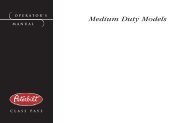Regional Haul Model Operator's Manual - Peterbilt Motors Company
Regional Haul Model Operator's Manual - Peterbilt Motors Company
Regional Haul Model Operator's Manual - Peterbilt Motors Company
You also want an ePaper? Increase the reach of your titles
YUMPU automatically turns print PDFs into web optimized ePapers that Google loves.
EMERGENCY EQUIPMENT<br />
Engine Compartment Checks — Daily<br />
1. Engine Fluid Levels—add more if necessary.<br />
• Engine oil<br />
• Coolant (check while engine is cold)<br />
• Power steering fluid level<br />
2. Engine Belt—check condition of belts. This is important<br />
to ensure proper air compressor and engine<br />
operation. If breaks or tears are found, the belt should<br />
be replaced before operating the vehicle.<br />
3. Fuel Filter/Water Separator Draining—check and<br />
drain. Depending on the fuel storage facility, more frequent<br />
draining may be required.<br />
4. Windshield washer reservoir fluid level—fill if necessary.<br />
5. Hood closed before entering cab. Is it latched properly?<br />
Chassis and Cab Checks — Daily<br />
Before entering the cab and operating the vehicle, check<br />
the following equipment for proper maintenance:<br />
DRIVER'S CHECKLIST<br />
1. Lights—do headlights, turn signals, emergency flashers,<br />
and exterior lamps function and are they clean<br />
and adjusted properly?<br />
2. Windows and Mirrors—are they clean and adjusted<br />
properly?<br />
3. Tires and Wheels—are they inflated properly? Are all<br />
wheel cap nuts in place and torqued properly—tighten<br />
if necessary. Check front wheel bearing oil levels.<br />
Inspect all tires and wheels for damage—correct if<br />
found.<br />
4. Suspension—check for loose or missing fasteners.<br />
Check damage to springs or other suspension parts.<br />
5. Brake Components—check lines, linkages, chambers,<br />
camtubes (for cracks or broken parts), and<br />
brake operation.<br />
6. Air System—are there leaks?<br />
• Air Tanks—drain water from all air tanks. Make sure<br />
the drain cocks are closed. This procedure is also<br />
required for air suspension tanks equipped with<br />
automatic drain valves.<br />
• See page 101 for further details on “Using the Brake<br />
System.”<br />
– 84 – Y53-6033 <strong>Regional</strong> <strong>Haul</strong> (R05/10)
















